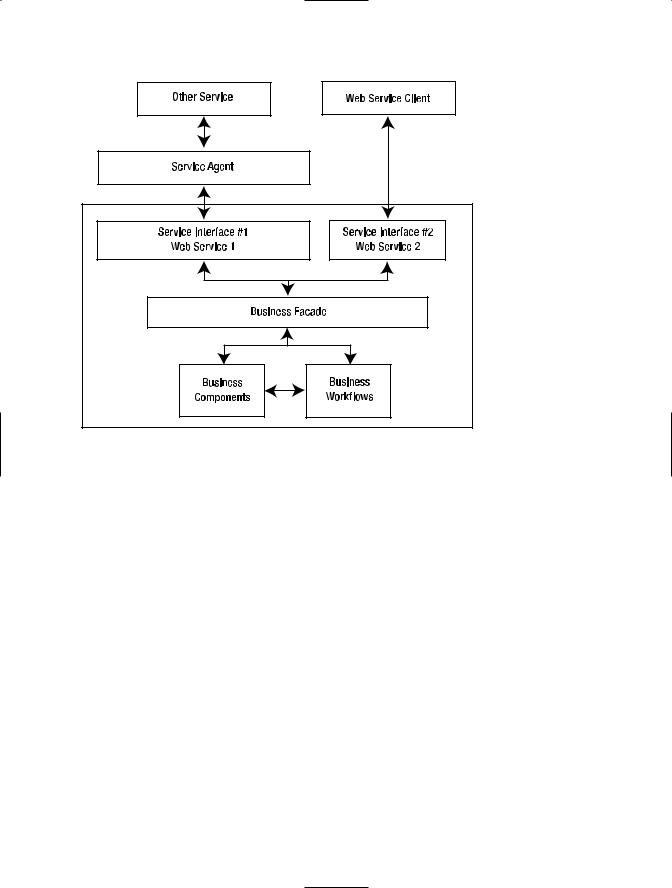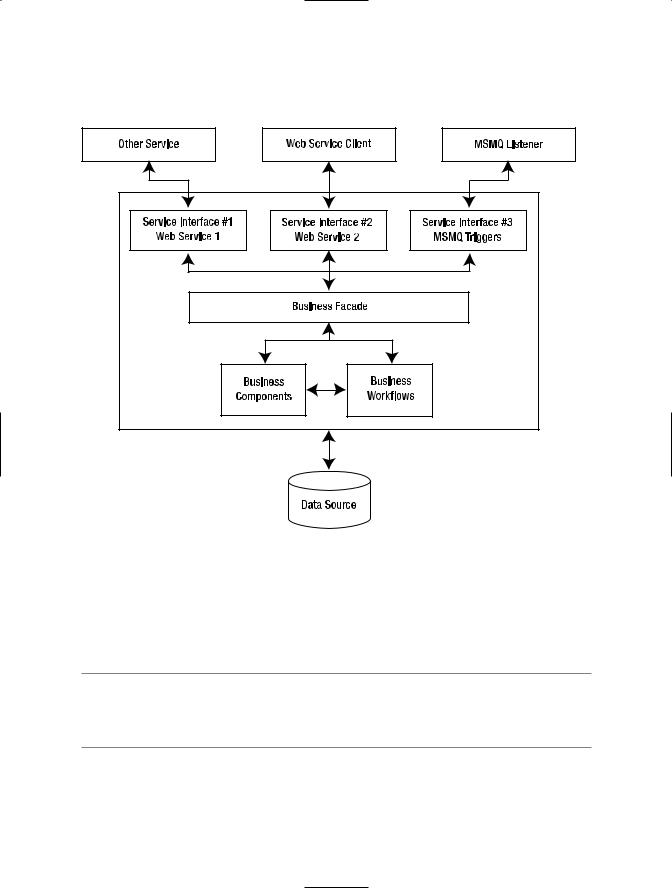
Expert Service-Oriented Architecture In CSharp 2005 (2006) [eng]
.pdf
6 C H A P T E R 1 ■ I N T R O D U C I N G S E R V I C E - O R I E N T E D A R C H I T E C T U R E
Services can also be registered in a UDDI registry, which enables them to be searched for by consumers and other services. The UDDI registry is very thorough and includes a reference to the WSDL contract information, as well as a summary of supported messages in a search-efficient format. This is useful for many reasons. For example, a consumer may only wish to call services that utilize a specific set of XSD schemas (such as industryspecific standard schemas). The UDDI registry enables that consumer to search for services that conform to this requirement.
Components of Web Service Architecture
Experienced developers are comfortable with n-tier application architecture, in which the components of an application are broken out across separate layers, or tiers. At a minimum, this includes the three classic layers: user interface (front end), business layer (middle tier), and data layer (back end).
Now let’s consider how an SOA solution is broken out in terms of layers and constituent components. Figure 1-3 illustrates a basic SOA solution.
Figure 1-3. Basic SOA solution

C H A P T E R 1 ■ I N T R O D U C I N G S E R V I C E - O R I E N T E D A R C H I T E C T U R E |
7 |
The box around service interfaces, business components, and business workflows represents the conceptual business layer (middle tier). This layer encapsulates the service interfaces, which in .NET terms are the .asmx Web service files and the code-behind that directly relates to verifying and relaying incoming messages (but excludes actual business logic). The .asmx files should delegate the business processing to dedicated business components and/or a business workflow process (essentially a sequenced chain of components in a workflow). This may be a different approach to Web services coding than you are used to, because, typically, all processing code is placed directly in the code-behind file of the .asmx Web service. In an SOA, it is important to design the Web service components themselves so that they truly act as gateways to dedicated business components or workflows.
The service interface has the following properties:
•It supports the communication requirements that the service specifies in its WSDL contract (specifically, in its binding information). This includes the format and transport protocols that the service responds to (e.g., SOAP over HTTP).
•It supports the security requirements that the service specifies. In .NET terms, the
.asmx code-behind can implement code that verifies incoming XML messages to ensure that they contain the required security tokens or headers.
•It supports the methods (operations) that the service specifies in its WSDL contract. In
.NET terms, the .asmx file provides methods that correspond to the service operations, but the actual business processing should be handed off to dedicated components and workflow.
Figure 1-3 also shows that there are two categories of service consumers that have entry points into the business layer. The first is a traditional user interface, shown on the left of the diagram, such as a Windows form or an ASP.NET web page. This type of user interface is part of the same domain where the service components reside. The second category of front-end consumers is the external Web service clients and other services, shown at the top of the diagram. These two categories are well-known to developers. If you develop a Web service for external use, you can just as easily call it internally within its application domain. Of course, it is more efficient to call the Web service’s delegated business components, because when you are internal to the domain, you do not need to route requests through the .asmx gateway using special transport and messaging protocols (e.g., HTTP and SOAP). This is yet another reason all Web services logic should be abstracted out to dedicated business components.
The architecture in Figure 1-3 is a good start, but it quickly breaks down under the demand of more sophisticated SOA applications. Figure 1-4 provides one example of a more complex SOA solution.

8 C H A P T E R 1 ■ I N T R O D U C I N G S E R V I C E - O R I E N T E D A R C H I T E C T U R E
Figure 1-4. Complex SOA solution
Figure 1-4 illustrates an architecture in which two separate Web services access the same back-end business components. Each Web service provides a distinct service interface, each of which is suitable for a different type of client. For example, Web Service 1 may provide access to a public, unsecured subset of functions, whereas Web Service 2 provides access to a restricted, secured subset of functions. In addition, Figure 1-4 introduces two new entities that play an important role in complex SOA solutions:
Service agent: The service agent manages communications between one service and another, or between a business object and an external service. In doing so, it simplifies those interactions by shielding translation quirks between the consumer and the provider.
Business facade: The business facade acts as a trust boundary between incoming service requests (from a client, another service, or a service agent) and the middle-tier business components that service those requests.
Let’s consider each of these in turn.

C H A P T E R 1 ■ I N T R O D U C I N G S E R V I C E - O R I E N T E D A R C H I T E C T U R E |
9 |
Service Agent
Business components are the engines of applications because they contain the logic to make the application work. In addition, business components know where to find information, whether it comes from a back-end database or from an external data source. In classic Windows-based n-tier architecture, we are used to thinking of business components as selfsufficient. But sometimes business components need to retrieve information from external sources in order to do their work. In SOA terms, sometimes business components need to call external services.
The service agent is responsible for managing communication between a business object and an external service. Service agents are extremely important because they simplify the amount of work that a business object has to do when it needs to use an external service. A service agent is a locally installed assembly that provides a well-known interface to the business object. Service agents do the manual legwork of communicating with external services and implementing whatever infrastructure is required to do so. This is useful for two important reasons:
•Business objects do not have to implement the infrastructure that is required to communicate with an external service. Instead, they communicate their requests to a local assembly (the service agent) using a mutually understood interface.
•Business objects avoid the maintenance work that is required to keep service interactions up-to-date. For example, if an external Web services interface changes, the service agent takes care of updating its proxy class and reworking the code implementation as needed. The business object can continue to communicate with the service agent in the same manner, even as the underlying communication details change.
We cannot resist using a travel analogy to describe the role that service agents play. Let’s say you and a friend are traveling in Madrid. Your friend is fluent in both English and Spanish, but is too lazy to read the guidebook and has no idea what to see in the city. You only speak English, but you read the guidebook cover to cover, and you know that the Prado Museum cannot be missed—if only you knew how to get there from your hotel. So you need to ask directions, but cannot communicate with the locals. Your friend can ask for directions, but needs to know from you where you are trying to go. The analogy is hopefully clear! You are the business component, your friend is the service agent, and the friendly locals act as the external service.
Business Facade
The business facade is not as intuitive as the service agent because it has no analogy in traditional component-based development. Essentially, the business facade is a trust boundary that sits between middle-tier business components and the service interfaces that call them. The business facade plays the roles of both a service agent and a service interface, and it only applies in situations where there are two or more service interfaces associated with the middle tier. It provides a common interface for multiple service interfaces to interact with. In addition, the business facade may provide additional security, authentication, or screening on incoming service requests.

10 C H A P T E R 1 ■ I N T R O D U C I N G S E R V I C E - O R I E N T E D A R C H I T E C T U R E
Figure 1-5 provides another SOA solution that illustrates the usefulness of the business facade.
Figure 1-5. SOA illustrating the business facade
In this example, the service layer must handle requests from a wide variety of services, and it must support three separate service interfaces. A business facade is necessary to manage requests from several incoming service interfaces and to ensure that the requests get communicated to the business components in a consistent fashion.
The concept of a business facade follows the well-known session facade design pattern. For an overview of this design pattern, please consult the article “Java Modeling: A UML Workbook” at http:// www-106.ibm.com/developerworks/java/library/j-jmod0604/.

C H A P T E R 1 ■ I N T R O D U C I N G S E R V I C E - O R I E N T E D A R C H I T E C T U R E |
11 |
WS-I Basic Profile, WSSpecifications, and
Web Services Enhancements
The difference between Web services technology today vs. SOA is in the level of available infrastructure support. Infrastructure in this context refers to the helper technologies and assemblies that support the implementation of an SOA solution. Stand-alone Web services require very little additional infrastructure support beyond what they already get from the
.NET Web services assemblies and the built-in HTTP handlers. However, as you have seen in the conceptual overview, SOA requires a lot of infrastructure support, including multiple transport options, security infrastructure, and support for reliable messaging, to name a few. Different companies, including Microsoft and IBM, are working together to establish standard specifications that cover the full range of supporting technologies for SOA infrastructure.
It is an unfortunate reality that Web services specifications are developed and advanced in a politically charged environment where companies are often rivals rather than partners. Corporate animosity causes companies to disagree on the right specifications. Sometimes different groups of companies pursue separate specifications that apply to the same purpose. Nonprofit organizations such as OASIS provide a forum for companies to cooperate in the advancement and development of Web services specifications. Read more about OASIS at http://www.oasis-open.org.
Introducing the WS-I Basic Profile
The Web Services Interoperability Organization (WS-I) has one primary goal: to establish standard specifications so that Web services can be interoperable across different platforms. In other words, the organization wants Web services to be able to work together no matter which platform they reside on or which development tool they were created with. The specifications cover a wide range of areas, from transport protocols to security, and are collectively grouped together as the WS-I Basic Profile.
■Note The WS-I Basic Profile is the first in what is expected to be several future and evolving profiles. The Basic Profile specifies exact version numbers for its compliant specifications. For example, it includes SOAP 1.1, WSDL 1.1, and XML 1.0. Future profiles will use updated versions, but it takes a long time to establish new specifications, so do not expect new profiles very frequently. View the WS-I Basic Profile Version 1.1 at http://www.ws-i.org/Profiles/BasicProfile-1.1-2004-08-24.html.
Figure 1-6 illustrates the high-level grouping of interoperable Web services specifications that have been published jointly by Microsoft, IBM, and others. The WS-I Basic Profile covers most of the specifications in the bottom three layers of the diagram, namely the specifications for Transport, Messaging, and Description. The additional layers are covered by the various WSspecifications including WS-Security, WS-Reliable Messaging, and WS-Transactions, to name just a few. Some of the WSspecifications fall within the lower three layers as well, including WS-Addressing for the Messaging layer, and WS-Policy for the Description layer.

12C H A P T E R 1 ■ I N T R O D U C I N G S E R V I C E - O R I E N T E D A R C H I T E C T U R E
Note that this figure is adapted directly from a joint Microsoft-IBM white paper titled “Secure, Reliable, Transacted Web Services: Architecture and Composition” (September 2003). Please see the “References” section in the Appendix of this book for more information.
Figure 1-6. Interoperable Web services specifications, including the WS-I Basic Profile
The high-level groupings of Web services specifications fall into these categories:
Transport: This group defines the communication protocols for moving raw data between Web services. It includes HTTP, HTTPS, and SMTP.
Messaging: This group defines how to format the XML messages that Web services exchange. It includes the SOAP specification for encoding messages, and the XML and XSD specifications for the message vocabulary. The specifications are independent of a particular transport protocol. The Messaging group also includes the WS-Addressing specification, which decouples destination information for the request from the underlying transport protocol. WS-Addressing can, for example, be used to define multiple destinations for an XML message.
Description: This group defines specifications that allow a Web service to describe itself. The core specifications are WSDL (for the service contract), and XSD (for defining data type schemas). It also includes the WS-Policy specification, which describes the policy that a Web service enforces when it communicates with a client. For example, a Web service may have specific requirements for how its interface operations are called. The WS-Policy specification allows the Web service to tell prospective clients what rules to follow in order to execute a successful service request. Finally, this group includes the UDDI specification for discovering and describing Web services.
Service Assurances: Web services cannot simply exchange XML messages. They must also provide the client with some assurance that the messages will be transmitted in a secure way and that the client can expect some kind of response, even if something goes wrong at some point in the workflow. This group of specifications includes WS-Security (which provides authentication mechanisms), WS-Reliable Messaging (to ensure the delivery of messages over unreliable networks), and several transaction-related specifications.

C H A P T E R 1 ■ I N T R O D U C I N G S E R V I C E - O R I E N T E D A R C H I T E C T U R E |
13 |
Service Composition: The wide array of specifications in the WS-I Basic Profile cannot be implemented in every Web service. Developers must pick and choose which specifications are important for a particular Web service. To enable this, Web services supports service composition, which allows developers to selectively pick specifications and to aggregate them and record them in the WSDL document.
Introducing the WSSpecifications
We introduce you to the WSspecifications again in Chapter 5, and then cover them in detail in the remaining chapters of this book. Briefly, here is a summary of the most important WSspecifications and their purposes:
WS-Security: Integrates a set of popular security technologies, including digital signing and encryption based on security tokens, including X.509 certificates.
WS-Policy: Allows Web services to document their requirements, preferences, and capabilities for a range of factors, though it is mostly focused on security. For example, a Web service policy will include its security requirements, such as encryption and digital signing based on an X.509 certificate.
WS-Addressing: Identifies service endpoints in a message and allows for these endpoints to remain updated as the message is passed along through two or more services. It largely replaces the earlier WS-Routing specification.
WS-Messaging: Provides support for alternate transport channel protocols besides HTTP, including TCP. It simplifies the development of messaging applications, including asynchronous applications that communicate using SOAP over HTTP.
WS-Secure Conversation: Establishes session-oriented, trusted communication sessions using security tokens.
WS-Reliable Messaging: Provides mechanisms to help ensure the reliable delivery of messages, even when one or more services in the chain are unavailable. This specification includes message delivery notifications so that a sender knows whether a receiver has successfully obtained a sent message. Note that WS-Reliable Messaging will be supported in the upcoming Windows Communication Foundation (WCF) release, formerly code named Indigo.
The WSspecifications are constantly evolving as new specifications get submitted and existing specifications get refined. However, the core set of specifications presented here will likely continue to form the cornerstone of specifications for some time to come, since they address essential requirements for SOA applications.
Introducing Web Services Enhancements
Web Services Enhancements (WSE) provides developers with .NET managed assemblies for implementing the WSspecifications in conformance with the WS-I Basic Profile. WSE is an evolving product and does not currently support all of the Web services specifications, but it does support many important ones, such as WS-Security and WS-Secure Conversation. Keep

14C H A P T E R 1 ■ I N T R O D U C I N G S E R V I C E - O R I E N T E D A R C H I T E C T U R E
in mind, though, that even currently supported specifications will continue to evolve in future releases of WSE. In some cases, this is because the specification is currently only partially implemented in WSE.
At a more conceptual level, WSE currently exists to provide additional infrastructure support for SOA solutions, beyond what is already provided by the .NET Framework. Microsoft chose to put WSE on a different release cycle than its .NET Framework releases, so that it would have the flexibility to vary the release schedule. Recall that SOA is governed by a number of technology standards and specifications that are themselves going through changes. WSE has to be on a flexible release cycle in order to keep up with the newer versions of these technology standards.
WSE is introduced again in Chapter 5 and is also the focus of the second half of this book, where we will cover the various WSspecifications in detail. WSE is what allows you to code several of the WSspecifications in message-oriented, service-oriented .NET applications.
■Note WSE 3.0 is now a fully supported product that is wire-level compatible with the upcoming WCF, and is scheduled for release at the end of 2006. This means that you can confidently build your Web services with WSE 3.0 without being concerned about needing future expensive and disruptive migration efforts to make your Web services WCF-compatible.
Summary
This chapter introduced the main concepts behind SOA, which refers to distributed applications based on Web services technology. We defined what Web services actually are, within the context of SOA, and reviewed the main aspects of SOA. We briefly introduced the WS-I Basic Profile, the WSspecifications, and WSE, all of which are covered in detail in the second half of this book starting with Chapter 5.

C H A P T E R 2
The Web Services Description
Language
Web services are formally and fully described using an XML-based document called the Web Services Description Language (WSDL) document. The WSDL document communicates metadata information about the Web service to potential clients and shows them what operations (methods) the Web service supports and how to bind to them.
Visual Studio .NET automatically generates WSDL documents for your XML Web services and uses them behind the scenes, although it conveniently allows you to avoid opening the actual WSDL documents. WSDL documents are, for example, used by Visual Studio .NET when you select the Add Web Reference menu option to allow your project to use the methods of an outside Web service.
In this chapter, we will describe the elements of a WSDL document so that you can understand how it fully describes a Web service. We will also show you those aspects of the WSDL document that you may wish to edit manually.
Elements of the WSDL Document
In an SOA, the WSDL document is a critically important document, and one that you will need to understand in detail so that you can exert tighter control over the Web services that you develop. This is because development tools such as Visual Studio .NET create the most generic WSDL documents with bindings only for the SOAP protocol.
Web services can exchange messages over several different protocols in addition to SOAP, including HTTP POST, HTTP GET, and SMTP. However, keep in mind that SOAP is the most suitable protocol for exchanging complex XML-based messages. If you have built a true service-oriented Web service, then these messages cannot, for example, be represented using simple URL arguments as are used by the HTTP GET protocol. You can use the HTTP POST protocol to exchange XML messages, but XML is not qualified with namespaces, nor does it provide the organized SOAP structure that is so critical to technologies such as WSE 2.0. You can see a comparison between the messages exchanged over SOAP vs. HTTP POST by browsing a Web service directly. Visual Studio .NET generates a generic input page for each Web method that shows you how the exchanged input and output messages will be generated.
WSDL documents fully describe a Web service, including the operations that it supports, the messages that it exchanges, and the data types that these messages use (both intrinsic and custom). The best way to approach a WSDL document is to understand that different XML
15
